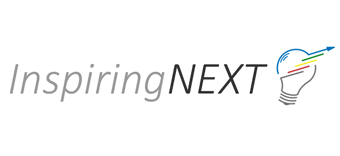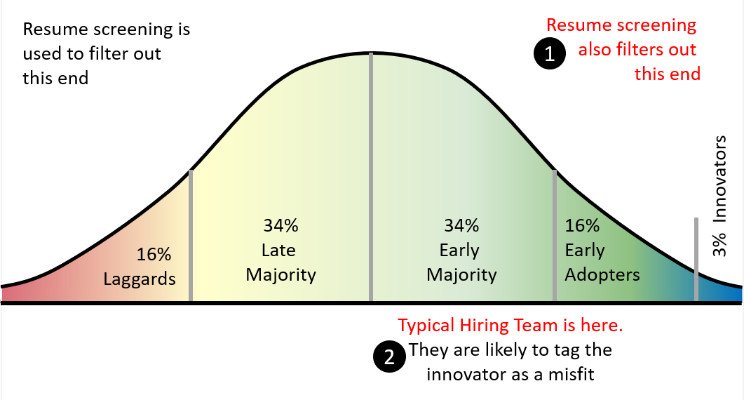How do you Hire an Innovator?
Please send me your resume in our standard template, to facilitate our process.
This is a response I received from an HR in 1999 for the job of an R&D Manager, when I sent them an interactive graphic resume, a novel concept at that time. I withdrew my application in a heartbeat. I knew immediately, they will not understand when I start doing serious research for them.
In so many similar instances, I am sorry to say that HR kills their first chance to spot an innovator, by making a specific size and shape of key hole for the candidate to apply through.
What’s up with the resume screening process?
Screening resumes is the process of eliminating candidates using successively more detailed examinations, to short list the most qualified candidates for interview. Thanks to social media and ease of submission, every job opening today gets an overwhelmingly large number of applications. Candidates use a blast gun approach and apply to hundreds of job openings. They call it playing the numbers game. Come on, this is not a lottery! But it probably has that perception, which has created burden on candidate to apply to 100s of jobs and recruiters to screen 100s of resumes for every job. Since we can’t reverse that easily, we have to manage through it.
To handle that unnecessary large volume, recruiters and HR have devised methods to speedup or automate the screening. There are reports that claim an average resume gets attention for a few seconds. This process, while eliminating the low performers and the mismatches on one end of the spectrum, unfortunately also eliminates the innovators on the other end, because they appear so different. They would not fit in a generic mold designed for the majority. A common phrase is, down play your resume to go through HR.
Many companies are deploying additional screening methods and tests like MBTI, DISC, etc. to get to the personality and target the right fit. Innovation type personality tests are beginning to emerge, but I have no direct personal experience in its use to comment on.
What’s up with the interview process?
If an innovator made it through the screening filter, then he or she will likely face a team/panel/committee and a fairly rigid process. Most companies have created standard protocols, questions, etc for interviewing the candidates. All these will further narrow the doorway closer to the mindset representing the mix of the hiring team, which is generally around the early majority with a hint of early adopters. In fact, during a recent interview experience with a large corporation, I discovered that the executives have 5 prewritten must ask questions to the candidate so HR can compare answers from various applicants and avoid potential discrimination law suit. I find this to be rather funny when you are in a competitive environment for talent acquisition. Furthermore, it drives a compliance mindset along the vertical, and for the new hire from day 1.
Let us not forget that even though, most managers would claim, they look for an out-of-the-box thinker, very few know how to handle one, and thus shy away from hiring one.
All this leads to picking of an above average candidate and hoping the performance of an innovator. Typical hiring process and teams are likely to tag the innovator as a misfit. You need an eye and a heart of an innovator to hire another innovator. So be selective about the interviewers.
Best Practices
During my career as a Technology Manager and R&D Group Head, I knew, I must recalibrate the screening process if I want to quickly build a team of innovators and forward thinkers. I wanted to ensure that I do not screen out creative minds based on my 1999 experience. I worked with HR and recruiting agency, so that I get to see all of the resume in raw form, from the candidate. I would personally read every resume and look for those sparks of genius that are rather uncommon and the candidate was expressing it cautiously. Yes, it took a few minutes for each resume, but it was worth it. I was not focused on subject matter words or achievements in numbers. Keywords such as highest, largest, first-time, pioneering, never before, changed, … used to catch my eye. Then, I would pick the phone and call the candidate without warning, outside of office hours, to capture his verbal reaction and seek clarification on a few of the claims that sound like creative activity on their resume. If found worthy of interview, HR helped me with logistics of onsite visit.
I was then very careful with the interview panel, and process. In addition to managers, the candidates went through discussions with my current R&D staff who would look for subject matter expertise and best fit. Finally, during my 1-1 interview, I would share my vision with them, of course protecting the company IP. My favorite candidates were those who questioned “Why this?” or “Why not that?” Then I would seek their preferred ideal role in the team. Their choice would tell me about their willingness and confidence to handle the unknown. Bingo. I found my next hire. Now if he or she is sold on my vision and we made the right offer, HR negotiations were quick and easy.
Once my admin assistant provided me a very different perspective on the candidate, from their conversation and his choice of journals and magazines in the waiting area. I broadened my interview process to include admin engagement.
The retention rates from a thorough hiring process are always higher, than those force fits by recruiting agencies. The new technologies and product development teams I built many years ago are still going strong.
Inspiring Innovators
True innovators are hard to contain. They are always itching to do something different, something new, and most companies do not have an endless supply of such opportunities. Even google has high turnover rate. To add insult to the injury most companies have a pretty standard performance appraisal systems, which typically do not reward innovation. Time and again, I have seen fire-fighters grow rather rapidly as compared to those who creatively avoid fires in the first place. Employees bringing instant cost savings to the department get better rank than those who invest in growth of the department. So many innovators put their personal energy and passion into something which has long term value and most of their managers fail to see the contributions or potential thereof, if it does not line up with their annual objectives. Top companies take special care of their top talent. Practices include, career tracks, networking peer groups, conference and industry committee participation, …etc. essentially, permitting the individual to outgrow the department without exiting. There are so many articles on talent retention and I have followed many of the recommended practices. Nothing works better than engaging them in developing vision for the company, leveraging their creative energy.
Dear Recruiters
I am sorry, your match making job is already hard, and it gets harder when asked to find innovators. Hiring innovators is an “eye for the quality game” and not a numbers game and most of your clients do not provide you with right incentives either. But if you partner with the hiring manager and recalibrate your “eye”, all three parties can win – you, the candidate and the hiring manager.
Dear HR Managers
I would urge you to study the resume of your innovators, and re-calibrate yourself with how they express themselves. Redefine your screening criterion to better spot the creativity. Work with hiring managers and supervisors during interview, assimilation and annual performance reviews. Help create a success criterion or metric which recognizes efforts that have long term returns.
R&D Directors, Please Engage
How do you spot “shiny eyes” and “crafty brains”? How do you nurture them? Share your story.

